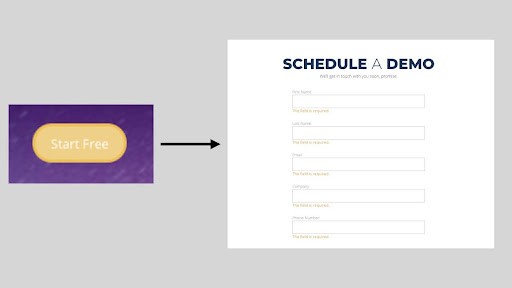SaaS
Why B2B SaaS Sales Is Broken: A Story
We’d been keeping our eye on one tool in particular for a while. It’s marketing automation and analytics software designed to help eCommerce companies optimize their customer experience. It has all the standard features and some that are really slick, including built-in clickstream data capture, profile stitching and intelligent customer segmentation.
When the product seemed to hit a level of maturity that indicated staying power, we decided we wanted to give it a try as a potential recommendation for our eCommerce clients. So, I went to the website and clicked the promising “Start Free” button. What happened next was the first indication that this purchasing experience wasn’t going to go smoothly…
Start Free?
“Start Free” didn’t actually mean “start using this product for free,” it meant “fill out this form where every field is required and wait on a sales person to contact you.”

Giving you all of this information isn't "free"
That wasn’t to my liking, so I tried the chat tool, where I was faced with a qualification bot that took longer to deal with than the form would have. (I also filled out the form, just for good measure.) When I finally jumped through enough bot hoops to chat with a real person, it was a sales person whose singular purpose seemed to be scheduling a meeting. Not a demo, just an “intro call.”
I wasn’t too happy that “Start Free” actually meant I would pay with my time. Still, the product was compelling enough for me to at least want to figure out how much it cost, because I couldn’t find anything about pricing on their website.
The intro call was fairly straight forward. I explained that I was interested in recommending this product to our clients, but that I wanted to try it out myself first in a few use cases to vet it (at Yield we don’t recommend products we haven’t used or vetted before). The Yield website is pretty clear about what we do and I stated my intentions up front, so I was surprised at how primitive the sales person’s qualification process was.
In fact, they never asked me which tools I’d used before, my level of competency with marketing software, or if I was comparing their product to others. At one point I tried to explain that using these types of tools is literally what our company does, but that seemed like a minor detail to the sales person. I did at least get more information on pricing, which seemed reasonable for the right type of business, which was encouraging.
No Soup For You
I was hoping to finally experience “Starting Free” at the end of the intro call, but the next step was a product demo, which was equally as frustrating. I won’t belabor the point, but the salesperson went through a scripted demo designed for someone who had limited experience with marketing SaaS (it was the antithesis of what Robert Falcone recommends in this article).
At the end of the demo, I said, “well, this looks great. I’d love to get my team in there so we can test the product out ourselves.” Here’s a recounting of the exchange:
Me: “Well, this looks great. I’d love to get my team in there so we can test the product out ourselves.”
» Sales rep: “Your company isn’t really a fit. Do you have a specific client in mind that you think is a fit for this product right now?”
Me: “So, you’re saying that it’s literally impossible for me to try the product out unless I recommend it to a client, even though I’ve never used it myself? Even if I would pay you as a customer?”
» Sales rep: “Yeah. I mean, unless a company like [names big company from client list on our site] wanted to use this, my hands are pretty much tied.”

But Let’s Be Fair
It’s easy to complain, and to be fair, I don’t know all of the specifics about the company or their customer acquisition strategy. I will say, though, the experience really felt like a venture-backed B2B SaaS company following the path of least resistance towards enterprise clients. Landing enterprise deals is a fast way to hit quarterly numbers, even if requires an antiquated, brute-force sales process.
Even though it wasn’t a great experience, I can say with confidence I admire what the company has accomplished. The product really does look awesome and it looks like they are scaling quickly. I just don’t think the way they are growing their business is the future of growth in B2B SaaS.
The Future Of B2B SaaS Sales
I don’t think the brute force sales strategy is going any where anytime soon in B2B SaaS, but I do think that method will provide increasingly diminished returns as time moves on.
The primary reason for that belief is that brute force sales funnels are full of painful friction. It may help acquisition teams quickly swat away deals that feel non-enterprise, but purchasers, even in the B2B SaaS space, are becoming less and less tolerant of friction.
That growing intolerance is compounded by the fact that 1) those same purchasers are becoming more educated and need less technical hand-holding or feature explanation and 2) there are many, many options for other SaaS products and that number is increasing. In other words, it’s getting easier, everyday, for people interested in your product to simply go on to the next one if there’s too much friction.
The best explanation I’ve seen of this trend is from Gokul Rajaram, who rightly claims that “truly great software companies are self-serve first.” Here’s the picture he paints of the coming struggle for SaaS companies relying on the brute force sales strategy (emphasis mine):
Obviously, one can point to several “non-self-serve-first” companies that have built strong businesses with a pure direct or inside sales model. And they, like my friend’s company, will do fine, for now. However, their growth, their customers, how fast they go global, will always be limited by how fast they can scale their sales team. Second, and more important, these businesses will be at constant risk of being disrupted by a self-serve-first competitor.
If the product I was interested in lives up to its promises, it’s likely that the company in my story will do well and possibly even exit to an enterprise player who can’t innovate fast enough. But the road they seem to be following will become steeper and steeper for similar companies who follow in their path.
Hard, Exciting Road Ahead
Self-service sounds great, but in his post Gokul is very clear that the road to building a great self-service SaaS company is extremely difficult:
A great self-serve product doesn’t automatically lead to a great business. It needs systematic and disciplined marketing and other go-to-market investment. One could argue that a sales-driven model is a much more predictable way to build a business.
Changing from a sales-driven acquisition model is daunting, not least because the landscape of of tools and skills needed to make the transition are really hard to pull together. But it’s also exciting—there’s never been a better time or better toolsets to create incredible, customer-centric experiences. At Yield we’re privileged to be on the front lines helping companies do that everyday.





